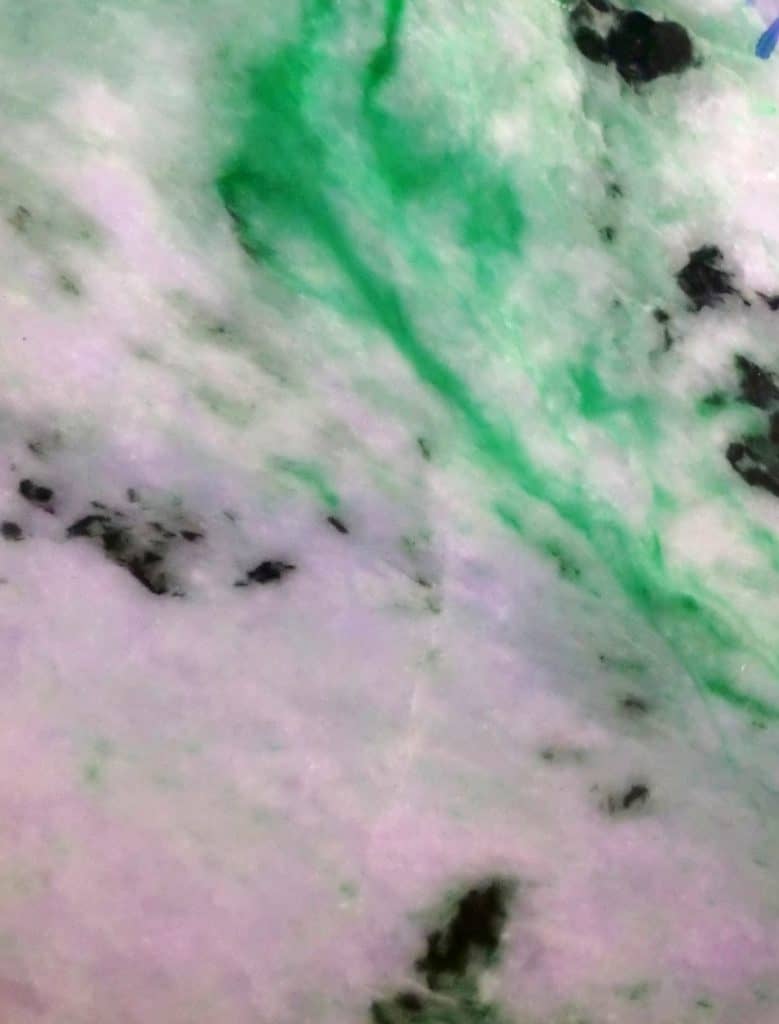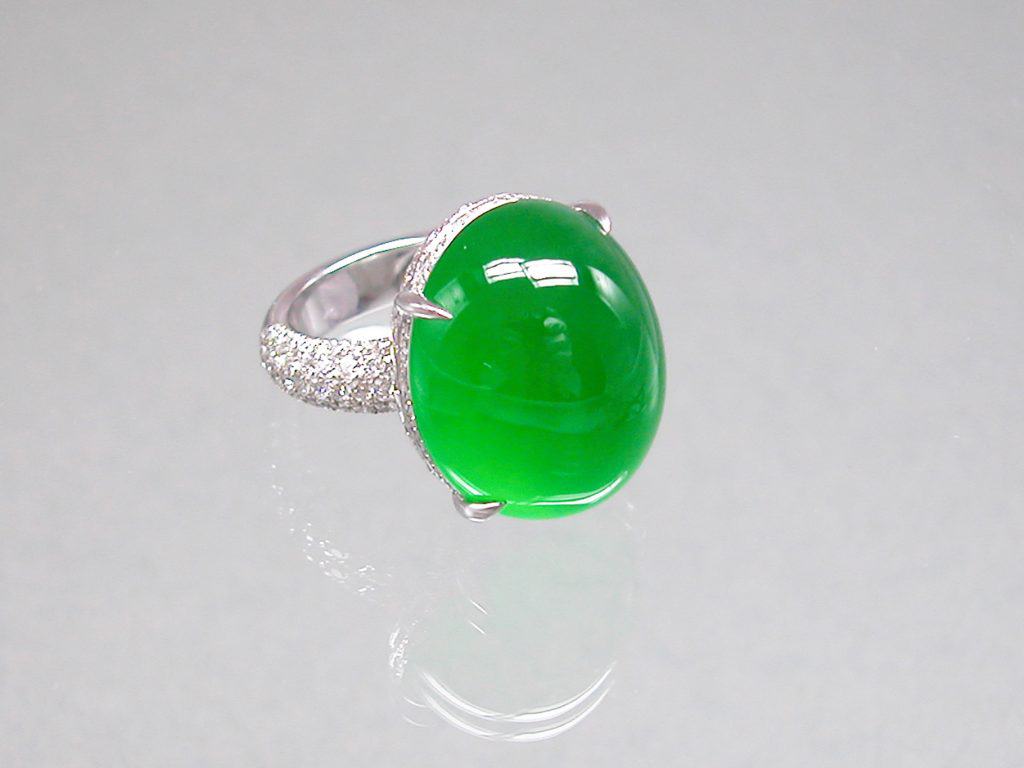
Jade, Stone of “Gods”: Terms, Concepts & Certification

by Dr. M.S. Krzemnicki, first published in Facette 19 (January 2012)
The History of Terms
Historically, the term jade derives from the Spanish “pie-dra de ijada” or stone of loins (deriving from the Latin word ilia for intestines and abdomen), based on the belief of native Indians in Mesoamerican cultures that ailments of the loins and kidneys (nephritis, an inflammation of the kidneys) could be cured with these stones (Nicolas Monardes 1565). But even in prehistoric European cultures, “jade” tools and ritual objects were highly sought after and traded throughout Europe. Well-known are jadeite-jade axes originating from small neolithic mining sites close to Monte Viso and Mon-te Beigua in Northern Italy (Pétrequin et al. 2006).
In China, the term “Yù” 玉 – literally “the most beautiful stone” – was used to describe jade, but also other hard material such as chalcedony and marble that was carved into tools and ceremonial objects since Neolithic times. Jade has always been a material to represent status and was considered the “imperial gem” from the earliest Chinese dynasties to the present. Due to its durability, the possibility to carve it in delicate designs and through its mere beauty, jade has become connoted with divine qualities such as protection, longevity, health, and luck in Asian cultures up to the present day (Jones 2004).
Concepts
Based on historic references, the Chinese understanding of the term jade is not equal to the Western understanding of the term, which has been defined (CIBJO) to consist either of jadeite (mineral of the pyroxene group) or nephrite, an inter-mediate member of the solid solution series between actinolite and tremolite (amphiboles). In the Chinese understanding, the term jade was historically separated into the terms Ying Yù (hard jade), mostly corresponding to pyroxenitic jade (also known as “Fei Cui” 翡翡) and Ruan Yù (soft jade), which apart from nephrite also includes minerals of the serpentine group (Xiù Yù jade, Henan) (Krzemnicki 2008) and even marbles (Lantian jade, Yuchuan quarry in the Shaanxi Province). Despite all the differences, the common understanding is that jade is a polycristalline aggregate made of fine and very densely interwoven mineral grains or fibres, which give it its outstanding workable properties.
As we see from the above, the term jade is rather historically defined and does not have a concise mineralogical definition. Its meaning has changed over time and is still nowadays understood differently in different cultures.
The scientific approach to describing “jade”-like materials is based on mineralogical identification. In many cases, this is quite straightforward, based on physical properties (e.g. SG, RI), chemical composition (e.g. ED-XRF), and structure (e.g. FTIR and Raman spectra). However, there are two aspects, which have to be considered.
1- These stones are in fact metamorphic rocks, and in many cases are mineralogically not fully homogeneous. Therefore, the analysed properties in many cases reflect a summarised composition rather than a grain-by-grain representation of the material. This is still valid in most cases, as long as we consider jade testing as the identification of a rock and not of a mineral species of defined composition. We must thus be aware that the indicated name reflects the main constituent of a sometimes more complex rock composition.
2- The second important aspect is that the minerals defined as belonging to jade (mostly jadeite and nephrite) are in fact members of large mineral groups (i.e. pyroxenes and amphiboles) with extensive chemical substitutions. As the definition of jade is not purely scientific and mineralogical, it is a matter of definition what compositional range is still accepted as jade or not. This is especially important if we talk about jadeite-jade and the acceptable amount of Fe and Mg concentration (e.g. omphacite compound), in order for it to still be considered jadeite-jade.
Based on the above, we can see that the identification of a stone as jade is not enough, as its composition remains too ambiguous. It is only by adding the mineralogical identity, i.e. nephrite-jade or jadeite-jade, that we can be specific enough to truly understand the nature of the material.
Mineralogical Definitions
Nephrite is actually not a mineral, but describes the massive and microcrystalline form of intermediate members of the tremolite-actinolite series, with a general formula Ca2(Mg,Fe)5Si8O22(OH)2. Nephrite belongs to the amphibole group and is a very typical formation of regional metamorphism. Nephrite consisting mainly of Mg-rich tremolite is white. Such white nephrite from Xin Jiang (Hetian Prefecture) is highly adorned in China as so-called “mutton-fat” jade. The more iron (actinolite compound) substitutes for magnesium, the more green the colour of nephrite. Nephrite often contains further minerals in minor quantities such as chromite, magnetite, and talc. Fe-oxides and hydroxides along grain boundaries and microfractures lead to yellowish to brown nephrite.
Nephrite is found in many places worldwide, with important and classic deposits in China such as the Yurungkash river (“white jade” river) in the Hetian Prefecture of the Xinjiang-Uygur Autonomous Region, and the Yuku peak in the Quinghai Province (Qinghai Jade) for green nephrite. Other historically important sources of nephrite are found around the Taramakau and Arahura rivers in Westland, southern New Zealand. The material, called “Pounamu” was crafted and valued by native Maoris due to its strength and transcendental qualities. Even in Switzerland, near the village of Poschiavo, close to the Italian border, there is a quarry with patchy and slightly greenish nephrite. This material was worked into objects and tools for a certain time until the mid 20th century.

Jadeite:
Jadeite is a member of the pyroxene group with the ideal formula NaAlSi2O6. Similar to the amphiboles, extensive chemical substitutions are possible, mostly involving chromium, iron, magnesium and calcium, and resulting in various pyroxene minerals. Pure jadeite is colourless, or mostly white when present as a microcrystalline aggregate. Minor amounts of chromium result in a vivid green colour of jadeite, also poetically described as “Imperial jade” in the Western trade. Interestingly, however, the colour becomes very dark green to even black when chromium dominates the composition (kosmochlor). Iron leads to a rather dull green colour becoming more greyish black with increasing concentration (omphacite to augite compound). Manganese traces result in a subtle to distinct violet colour, also known as “lavender jade”. Similar to nephrite, jadeite rocks may additionally be coloured by small mineral inclusions or Fe-oxides and hydroxides accumulated along grain boundaries and (micro-) fractures. Jadeite is found only in a rather limited number of deposits in economically important quantities and qualities. The most important sources are found in Upper Bur-ma (Myanmar) near Hpakan (Hughes 1999) and historically important sites near Montagua region in Guatemala (Taube et al. 2004).

Mineralogically speaking, jadeite NaAlSi2O6 forms a so-called solid solution series (at least partially) with other pyroxenes, mainly kosmochlor NaCr Si2O6, aegirine NaFe3+Si2O6, diopside CaMgSi2O6, augite (Ca,Na)(Mg,Fe2+,Al)Si2O6, and omphacite, an intermediate variety between augite, aegirine, and jadeite. As in nature, pure end-members of the above minerals exist only rarely, the definition of the mineral species includes a certain (defined in mineralogical literature; see e.g. Deer Howie & Zussman 1992) amount of mixed chemical compositions. This is very similar to the garnet group and the tourmalines, just to name a few.
Although physical properties between the above-mentioned pyroxene minerals vary considerably, a definitive identification of whether the stone belongs to jadeite or to one of the other pyroxene solid solution members is only possible by quantitative chemical analysis. This may lead to the conclusion that even a stone with visual appearance quite similar to those of a jadeite-jade, is in fact not a jadeite.
Gemmological Denominations
Nowadays, it is common practice in the trade to specify whether a jade is a nephrite-jade or a jadeite-jade. In Asia, the term “Fei-cui 翡翡” is also used to describe jadeite-jade. Promoted by the creation of an ISO standard for Fei Cui testing (HOKLAS ISO 17025; August 2006), this historic term is gaining more importance in the Asian market. As a member of the Technical Board of the Fei Cui Testing Methods and Laboratory Manage-ment System Development Project (Hong Kong), the author is also involved in these issues. It is, however, important to understand that creating a “new” gemmological term is also challenging. For the Japanese, the term Fei Cui is synonymous to jadeite-jade; whereas, in the Chinese market, omphacite and kosmochlor-rich members of the pyroxene group are often also included in the term Fei Cui.
The SSEF regularly certifies “jade” for the trade. Being a gemmological laboratory with a scientific approach, we strictly use mineralogical and chemical parameters to identify jade, either as nephrite-jade or jadeite-jade (Hänni 2007) and to disclose any treatments applied on these stones. Apart from classical gemmological methods, meticulous chemical (ED-XRF) and structural (FTIR, Raman) analyses are fundamental to our testing approach. Although quality grading is an issue in parts of the trade, there are many factors that contribute to the beauty and value of jade of finest quality, which make the application of any such “grading” system a very difficult task. That is why we do not grade the quality of jade, just as we do not grade rubies, sapphires or other coloured stones and natural pearls. However, it is our policy to add an appendix letter for exceptional items, describing in detail the features which contribute to the beauty and rarity of such a gem, thus adding a premium to an outstanding jade.



